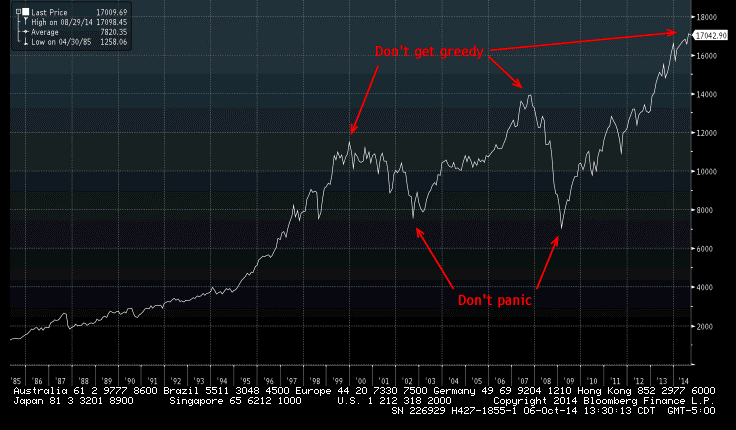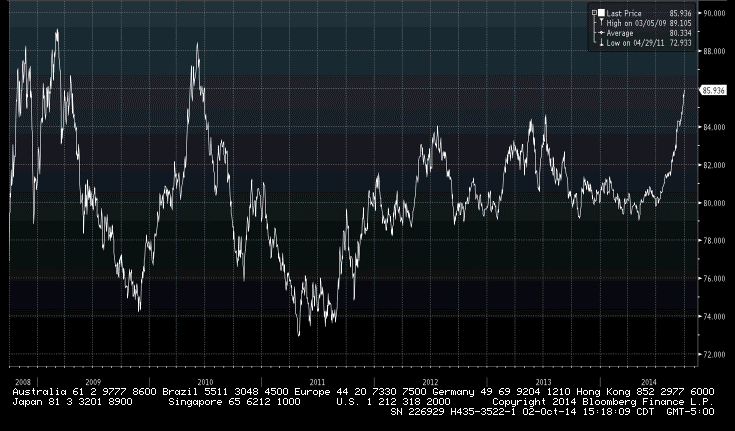This past week the Kansas City Royals qualified for the playoffs for the first time since 1985, the year they won the World Series. That 29-year drought was the longest non-playoff drought of any major sports franchise in America. George Brett led the Royals to the 1985 World Championship, and there are many young children in Kansas City today who think about George Brett the same way I think about Babe Ruth. He was good. He played a long time ago. So what?
It was so long ago that there are 26 players on the current 40-man roster who were not yet born in 1985. A few of them have older siblings who were not yet born in 1985.
Out of curiosity, I checked 1985’s notable headlines, and my findings really illustrate just how long it has been since the Royals have been in the playoffs.
- Ronald Reagan was president. Reagan, who has been dead for more than ten years, was just about halfway through his eight-year stint in the White House the last time the Royals were in the playoffs.
- Reagan’s vice president was George Bush (the first one) and he was elected president in 1988. Years later, his son would serve eight years in the White House.
- People were dying of AIDS in 1985. Although there is still no cure for AIDS, it is not quite the death sentence it was in 1985. Twenty-nine years from now, we may look back on 2014 as the year of the Ebola virus… but I hope not.
- Microsoft released Windows 1.0 (that’s ONE POINT OH!, as in the VERY first version).
- The first mandatory seat belt law was enacted. It seems crazy in retrospect that for many years our culture felt it was okay for little children to stand up in the back seat while flying down the road at 60 MPH. Fortunately, for the past 29 years, that has officially been deemed a bad idea.
- The Dow Jones Industrial Average (DJIA) closed at 1,329.19 on September 30, 1985. This September 30th, it closed at 17,042.90, an annual return of 12.1% if you were able to not panic during the bear markets, and if you didn’t get too greedy at the top of the bull markets. The graph below shows the DJIA from 1985. As you can see, now is probably not the time to get very greedy.

- The interest rate on the 10-year Treasury bond was over 11%. Today it is just under 2.5%.
That last bullet point is interesting (no pun intended). A 10-year Treasury yield over 11% seems really high, but that was down from almost 15% in 1982! We’re not talking about some third-world emerging economy. In the early 1980s, money market funds in the U.S. paid over 18%. We were on the heels of a decade of hyper-inflation and the Federal Reserve Bank raised interest rates in order to whip inflation. This is the type of inflation and interest rate scenario that so many investors have been warning us about for the past six years.
1985 was the early stages of an 18-year bull stock market (1982-2000) and a 30+-year bull bond market. As interest rates declined from unprecedented high levels, both bonds and stocks increased in value. Investors didn’t have to be smart in order to look smart during a period like that. However, since 2000 being smart has been more in demand. A healthy dose of humility is also an asset.
The first documented case of the Ebola virus was diagnosed in the United States last week. The patient in Dallas, Texas had recently returned from Liberia, which is pretty much “ground zero” for the Ebola virus. He apparently exhibited no symptoms for several days after returning to the U.S.
This is the worrisome thing about the Ebola virus. You can have it without knowing you have it for several days. According to the experts, you are not actually able to transmit it to other people unless you are exhibiting symptoms. However, I don’t know anyone who is willing to test that theory.
Although more cases of the Ebola virus may ultimately be documented in the U.S., I am confident our methods of dealing with the spread of the virus will be more effective than those used in the African countries. But then again…
What I am NOT confident about is the public’s reaction to even a mild spread of the Ebola virus. I wrote about this two months ago in the Ebola and Uber commentary. The Ebola virus doesn’t have to become a pandemic for it to ruin an economy. It just has to make people THINK it is going to become a pandemic to ruin an economy. It may not take much to scare consumers away from places where you come into contact with people like restaurants, movie theatres and airplanes.
If and when that occurs, we would likely experience a significant slowdown in economic activity. And the stock market, which has been on a five and a half year bull run, won’t have any trouble using the Ebola virus as an excuse to sell off.
Other dangers that have surfaced because of the Ebola virus are investment scams. The Financial Industry Regulatory Authority (FINRA) recently made the following statement:
“Be wary of promotions touting stocks that claim to protect against the spread of viruses or other harmful diseases. Aggressive stock promotional tactics may signal a potentially fraudulent scheme.”
FINRA reminds you to:
- Consider the source: Press releases and emails hyping a company and its products are designed to separate you from your money. (I paraphrased their language rather liberally.) And always ask yourself the ultimate DUH! question: if it’s such a great deal, why are they cutting you in on it?
- Do some sleuthing: Actually you don’t need to do this because we sleuth for you. We are the sleuthers. You hired us to sleuth and that’s what we do. If we think investing in some tiny company no one has ever heard of because a cousin’s friend’s brother-in-law heard they found a cure for the Ebola virus, we will make that investment for you. Please ignore the cousin and the friend’s brother-in-law.
- Read a company’s SEC filings: Only if you are having trouble sleeping at night should you do this. Like the sleuthing, leave this one to us.
Bottom line: There is a very good chance the Ebola virus cure will not present the investment opportunity that you can brag about at your next social gathering. Just tell your friends who are bragging about their great investments (they won’t tell you about their losers) that you have sleuthers who are handling this for you. Leave it at that.
For the past five years, I have heard many tales and received many emails detailing all the reasons why the U.S. dollar is going to lose its value. Too much debt, excess government spending, Obamacare, etcetera, etcetera. Investors who felt this way were recommending investments in gold, farmland, ammunition and canned goods. I never bought into it, but I listened. It was the polite thing to do.
Perhaps they will be right someday, but recent dollar activity makes them look dead wrong. The chart below shows the value of the U.S. dollar versus a basket of other major currencies for the past six years. As you can see, in the past two months, the dollar has been on a tear.

What’s important to remember is that the value of the dollar is RELATIVE to the value of other currencies. And as long as other nations are screwing up their financial system worse than the U.S. is, the dollar will have no trouble maintaining its value. And it might even increase in value. Don’t look for it to sell off any time soon.
The investment ramifications of a strong dollar can be confusing. For American companies that sell products overseas (e.g. “multi-nationals” like Coke, Ford, major pharmaceutical companies, etc.), a strong dollar can be negative. Because the dollar is strong, their products now cost more for foreign consumers so they sell fewer of them.
It gets worse. The profit they earn from selling fewer products is reduced when they convert their foreign currency back into dollars because the dollar is so expensive. Unless, of course, they just leave those profits in the foreign currency indefinitely or execute a corporate “inversion” (see Mid-term Elections and the ECB).
Companies whose sales are limited to the U.S. have an advantage over multi-nationals in that their sales are not directly affected by a strong dollar.
Foreign manufacturers (Toyota, Volkswagen, etc.) benefit from a strong dollar because their products now become cheaper for the U.S. consumer, causing us to purchase more of their product. And when they convert the dollars they earn from selling their products to us back into their cheap currency, they get an extra boost.
Having a desire for your currency to be strong can fall under the heading, “Be careful what you wish for.”
The stock market had a very rough start to October with the S&P 500 declining over 1% in the first two days, then recovering most of it on the 3rd. The Department of Labor announced that companies in the U.S. added 248,000 new jobs in September, reducing the unemployment rate to 5.9%, the lowest it has been since before the recession. Granted, a reduction in the participation rate contributed to the decline in unemployment (just like it does almost every month), but the fact is that unemployment continues to decline and the economy continues to grow (slowly).
At Boyer & Corporon Wealth Management, we feel the economy will continue to grow (slowly) barring an unexpected outbreak of the Ebola virus. We feel stocks are good to own long-term. However, stocks are not cheap, and we are noticing that market sell-offs are coming much more frequently and easily. Market rallies are less frequent and don’t seem to have nearly as much conviction. We have been selling call options and are looking for other ways to hedge our equity positions.
This information is provided for general information purposes only and should not be construed as investment, tax, or legal advice. Past performance of any market results is no assurance of future performance. The information contained herein has been obtained from sources deemed reliable but is not guaranteed.
